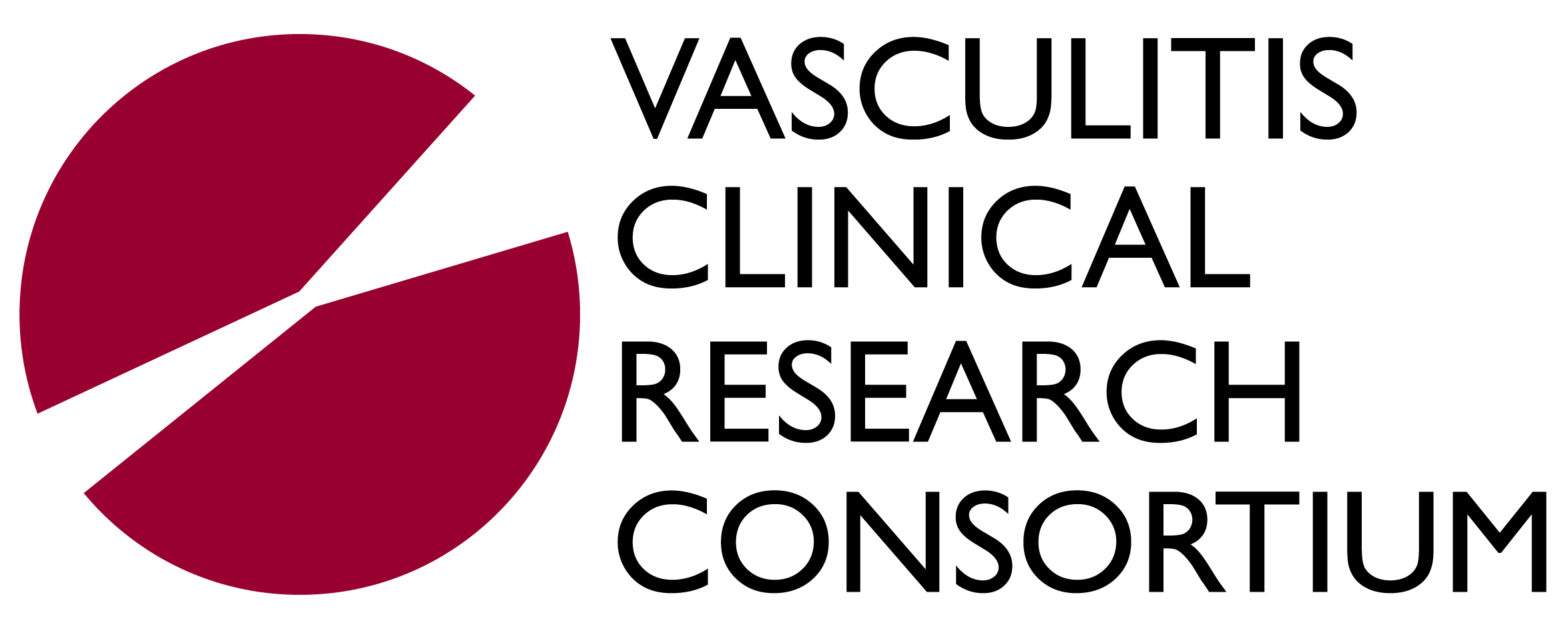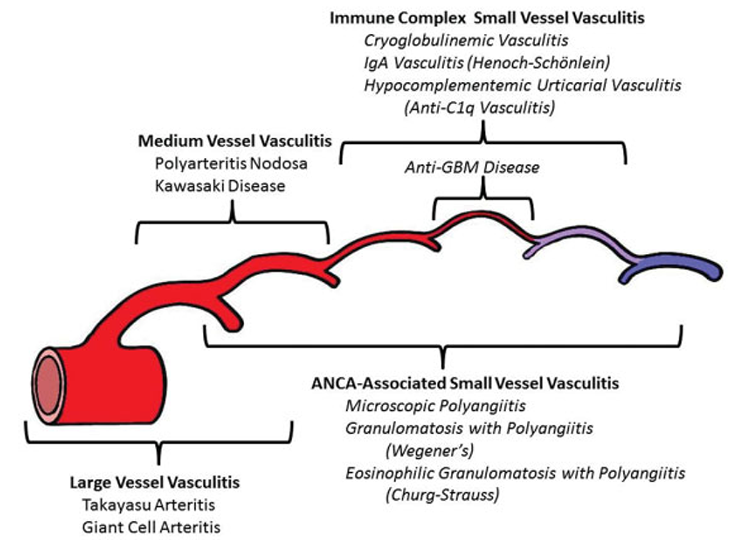Diseases Studied
There are several forms of vasculitis. While some forms are due to infection or may be associated with other diseases, the causes of the six kinds of vasculitis which are the main subject of the VCRC network are unknown. They are all autoimmune diseases.
Different forms of vasculitis cause inflammation in blood vessels of various sizes. Some affect mainly small blood vessels such as those in the skin and the back of the eye, while others can affect medium sized blood vessels like those going to the hands and feet and the coronary arteries. Others affect mainly large blood vessels, like the aorta. However, there can be considerable overlap in the blood vessels which are involved by a given form of vasculitis. In all forms, the wall of the vessel can become weakened, even resulting in rupture of the vessel and damage to the tissues supplied with blood by the vessel. The inflammation can also lead to thickening of the vessel wall, causing blockage of blood flow and therefore to tissue damage.
The diagnosis of vasculitis is based on a combination of symptoms, laboratory tests and biopsies of affected tissues. Most laboratory tests used to evaluate patients with vasculitis are non-specific. For example, the sedimentation rate may be high when the disease is active. One laboratory test is called antineutrophil cytoplasmic antibody, or ANCA, which can be present in some forms of vasculitis. Magnetic resonance imaging (MRI), computerized and dye studies of blood vessels called angiograms are among radiology tests used for evaluating patients with vasculitis. The specific tests used in diagnosis and in assessing the treatment of vasculitis depend on the type of vasculitis and the blood vessels and organs involved.
All forms of vasculitis are treated with glucocorticosteroids (“steroids”), and many require treatment with other drugs as well, including drugs used to suppress the immune system (“immunosuppressive agents”) as well as drugs used in the treatment of cancers and other conditions. Increasingly, drugs including newer “biologic agents” are being used in the treatment of some newer forms of vasculitis.
Aortitis
A rare disorder caused by inflammation of the aortic wall. This is an autoimmune disease with no known cause or trigger.
Learn MoreBehcet's Disease
A rare, multisystemic disorder affecting the mouth, genitals, skin, eyes, central nervous system (consisting of the brain and spinal cord), digestive tract, blood vessels, and joints. Symptoms include inflammatory ulcers around the mouth and genitals, skin lesions, eye inflammation, blurry vision, joint pain and swelling, aneurysms (weakened areas in artery walls), blood clots, diarrhea, headache, fever, stroke, poor balance, and confusion.
Learn More from VCRC Learn More from GARDCentral Nervous System (CNS) Vasculitis
A rare disorder characterized by inflammation of the blood vessels of the central nervous system (brain and spinal cord). There are two forms. The primary form occurs without an underlying condition, while the secondary form is caused by underlying conditions such as autoimmune disorders or systemic infections. Symptoms include severe headaches, swelling of the brain, stroke, forgetfulness, confusion, vision problems, seizures, ataxia (lack of coordination), muscle weakness, and sensory disturbances.
Learn MoreCryoglobulinemic Vasculitis
A rare, autoimmune disorder in which a person's own body attacks itself via antibodies (immune defense proteins) in the blood that form abnormal protein complexes that thicken and clump together when exposed to cold temperatures. This process restricts blood flow to joints, muscles, and organs and causes blood vessel inflammation. Symptoms include joint pain, muscle weakness, purplish skin lesions, skin ulcers, hives, and necrosis (tissue death) of the extremities, especially the fingers and toes.
Learn More from VCRC Learn More from GARDCutaneous Vasculitis
A rare disorder characterized by inflammation or necrosis (tissue death) of blood vessel walls and skin lesions. Skin lesions commonly come and go, affecting the back, hands, buttocks, lower extremities, and inner forearms. Symptoms include intense itching, skin ulceration, blisters, darkened spots, scarring, fever, joint and muscle pain, and malaise (general discomfort).
Learn MoreDrug-Induced Vasculitis (DIV)
A rare, secondary disorder characterized by blood vessel inflammation, leading to blood vessel wall thickening, weakening, narrowing, or scarring. This disorder is caused by use of certain medications, such as illicit drugs or medications prescribed to treat specific bacterial infections, cancers, autoimmune (body attacking itself) disorders, or psychological disorders. Symptoms include skin rash, muscle and joint pain, malaise (general discomfort), and fever.
Learn MoreEosinophilic Granulomatosis with Polyangiitis (Churg-Strauss) (CSS)
A rare, multisystemic disorder affecting the lungs, kidneys, digestive tract, and extremity nerves. It is characterized by the abnormal clustering of white blood cells called eosinophils in the blood and tissues, vasculitis (blood vessel inflammation), and formation of granulomas (inflamed nodular lesions). Symptoms include allergic reactions, asthma, lung abnormalities, dyspnea (difficulty breathing), coughing, wheezing, malaise (general discomfort), fever, muscle and joint pain, loss of appetite, and weight loss.
Learn More from VCRC Learn More from GARDGiant Cell (Temporal) Arteritis (GCA)
A rare disorder which is the most common blood vessel disorder affecting individuals over the age of 50. It is characterized by arteritis (inflammation of the medium and large-sized arteries in the body), particularly affecting the cranial (brain) arteries, especially the temporal arteries (arteries in the temples). Changes to affected artery walls over time result in poor blood circulation. Symptoms include headaches, visual disturbances, aneurysms (weakened areas in artery walls), stroke, fever, fatigue, malaise (general discomfort), depression, weight loss, and anemia (low red blood cells).
Learn More from VCRC Learn More from GARDGranulomatosis with Polyangiitis (Wegener's) (GPA)
A rare, autoimmune (body attacking itself) disorder characterized by blood vessel inflammation, primarily affecting the lungs and kidneys. Symptoms include upper respiratory and ear infections, hearing loss, persistent runny nose and cough, nasal congestion, nosebleeds, sinus and lung inflammation, difficulty breathing, wheezing, vocal changes, fever, malaise (general discomfort), weight loss, loss of appetite, fatigue, muscle and joint pain, renal (kidney) disease, high blood pressure, leg swelling, and pleural effusion (excessive fluid accumulation in the lungs).
Learn More from VCRC Learn More from GARDIdiopathic Aortitis
A rare, autoimmune (body attacking itself) disorder characterized by blood vessel inflammation, primarily affecting the lungs and kidneys. Symptoms include upper respiratory and ear infections, hearing loss, persistent runny nose and cough, nasal congestion, nosebleeds, sinus and lung inflammation, difficulty breathing, wheezing, vocal changes, fever, malaise (general discomfort), weight loss, loss of appetite, fatigue, muscle and joint pain, renal (kidney) disease, high blood pressure, leg swelling, and pleural effusion (excessive fluid accumulation in the lungs). A rare disorder characterized by inflammation of the wall of the aorta (the largest artery in the body which transports blood from the heart to the rest of the body). While most forms of aortic inflammation have identified systemic causes, the cause of this form is unknown. Imaging may reveal aortic aneurysms (weakened areas in artery walls) and abnormal aortic wall thickening. Typically, affected individuals are asymptomatic (without symptoms), while others have abdominal or back pain, fever, or pulsing abdominal masses.
IgA Vasculitis (Henoch-Schonlein purpura)
A rare, immune system disorder characterized by accumulation of immunoglobulin A (a specific antibody protein) in small blood vessels. This causes inflammation and leakage of blood, affecting the skin, joints, digestive tract, kidneys, and, rarely, the nervous system and lungs. The most common symptom is purpura (a red or purple skin rash). Severe cases may lead to acute kidney injuries that progress to chronic kidney disease.
Learn More from VCRC Learn More from GARDMicroscopic Polyangiitis (MPA)
A rare disorder characterized by blood vessel inflammation, most commonly affecting the kidneys, lungs, nerves, joints, and skin. The cause of the disorder is poorly understood, but may occur due to gene mutations, infections, or autoimmune (body attacking itself) disorders. Symptoms include skin lesions, muscle and joint pain, fatigue, weakness, fever, sensory changes due to nerve damage, weight loss, leg swelling, dark urine, cough, difficulty breathing, and ear, eye, and sinus problems.
Learn More from VCRC Learn More from GARDPolyarteritis Nodosa (PAN)
A rare, multisystemic disorder characterized by widespread blood vessel inflammation, weakening, and damage, specifically to small- and medium-sized arteries. The kidneys, heart, muscles, intestines, and nervous system are affected, causing high blood pressure, aneurysms (weakened areas in artery walls), blood clots, joint and muscle pain, kidney disease, and tissue damage or necrosis (tissue death) due to blocked blood flow.
Learn More from VCRC Learn More from GARDTakayasu's Arteritis (TAK)
A rare disorder characterized by inflammation of one or more arteries transporting blood from the heart to the body, including the aorta (largest artery) and pulmonary (lung) artery. Symptoms include malaise (general discomfort), muscle and joint pain, arterial narrowing or blockage, lightheadedness, syncope (fainting), absent pulses, aneurysms (weakened areas in artery walls), aphasia (speech problems), photophobia (light sensitivity), blindness, cool skin, muscle weakness, and problems measuring blood pressure.
Learn More from VCRC Learn More from GARDUrticarial Vasculitis
A variant of cutaneous vasculitis characterized by small blood vessel inflammation, causing red, painful, raised patches (weals) on the skin that resembles urticaria (hives). There are two types: normocomplementaemic and hypocomplementaemic, indicating either normal or low levels of complement proteins (proteins that fight infection) in the blood. Symptoms include abdominal or chest pain, fever, joint and muscle pain, and angioedema (swelling of the skin or mucous membranes).
Learn MoreOther Types of Vasculitis
A term describing inflammation of the blood vessels (arteries, veins, or capillaries). When this inflammation occurs, it causes changes in the blood vessel walls, such as abnormal thickening, weakening, and narrowing which can progress to the point of occlusion (blood vessel blockage). Consequently, this results in lack of blood flow to tissues and organs supplied by affected vessels.
Learn More

